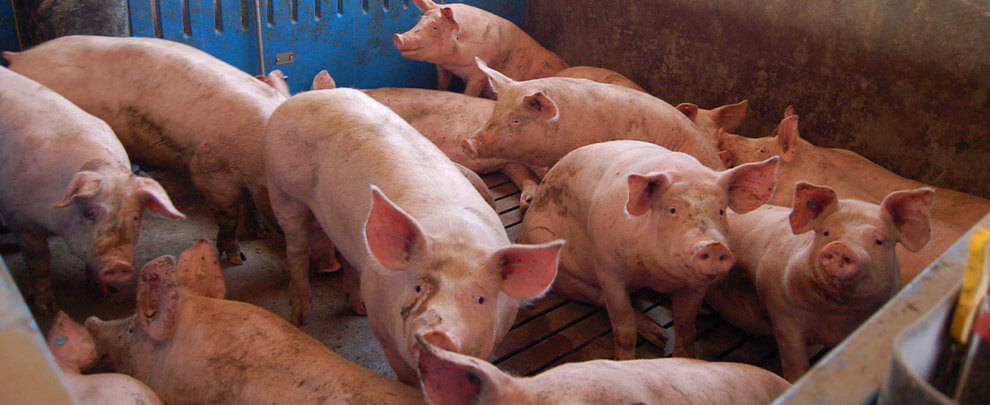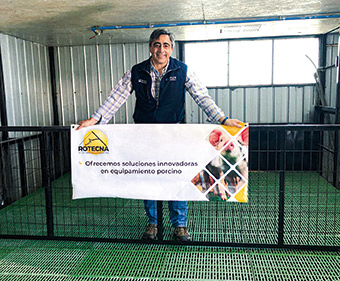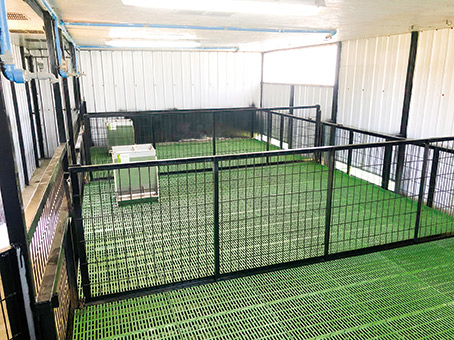Blog
Blog

A Chilean university develops a vaccine against Lawsonia
03rd February 2022 - News
In Chile, all farms are seropositive to Lawsonia intracellularis, a disease that can cause a severe digestive problem in pigs and can mean significant economic losses for farmers. Last September, the University of Concepción in Chile began a project to develop an alternative injectable vaccine to control this disease. To learn more about this project, we spoke with Álvaro Ruiz, associate professor at the University of Concepción de Chile and researcher of this project.

Álvaro Ruiz G. in the experimental unit. Photo: Álvaro Ruiz G.
What is Lawsonia intracellularis?
It is a bacterium that, as the name suggests, is intracellular. It causes a severe digestive issue in intensively produced pigs, especially in new herds, causing significant damage and economic losses.
What impact does it have on the Chilean pig sector?
Currently, in Chile, all farms are HIV-positive in Lawsonia. Although there are commercial vaccines for its control (an oral one administered with water, and another injectable one, from two large international pharmaceutical companies,) vaccination is relatively recent, and Lawsonia is still a significant problem. Specifically, it can cause, mainly, two different cases: an acute state, which can be fatal, with hemorrhagic enteritis, and a chronic one, where there is a thickening of the wall of the intestine, which implies a progressive thinning of the animals due to malabsorption of nutrients in the intestine.
What effects does the entry of this disease into a farm have?
When it enters for the first time and has no antibodies, it produces an acute state, with high mortality. Then chronic and/or subclinical conditions that seriously affect the productive parameters have a tremendous economic impact. In the end, all subclinical and chronic diseases are a big problem, as you don’t realise you have it until it’s very apparent.
When and how did the project to develop a vaccine for Lawsonia intracellularis begin?
I am part of a team made up of professionals from the Faculties of Veterinary Sciences and Biological Sciences of the University of Concepción that has been developing vaccines for ten years. Specifically, we work on diseases that need research and a solution. In this line, seven years ago, we started a work project on Lawsonia, when there was only the oral vaccine, not the injectable one. We began to investigate the possibility of having an alternative injectable vaccine for the control of this disease. Thus, we managed to design a prototype vaccine, with which we won a project funded by the Chilean government that allowed us to carry out all the tests and obtain an initial formulation with an immune response. We have just been awarded a second project to select a better quality adjuvant and adjust the antigen concentration to achieve better protection.
What is the project?
The project began in September and will last two years. In the first stage, we will test different adjuvants and different concentrations of the antigens in the vaccine prototype. We have three different antigens, and now we’re going to try them together and separately to see which option offers the best antigenic response. In the second stage, we will carry out a trial consisting of an experimental inoculation with animals vaccinated with our vaccine and with a commercial vaccine. Our aspiration under no circumstances is to have a better response to the commercial vaccine but to get as close as possible to it to offer the farmer more vaccination options.
What phase of the trial are they in?
Now we are in the first phase in which we have to demonstrate again, with the new formulation, that there is no local reaction or inflammatory process in the injection area. It will be a study with 20 animals focused on taking samples at the injection area (biopsies) to show no adverse effects and evaluate the serological response.
What are the characteristics of this experimental unit?
It is a warehouse with a capacity for 90 animals up to 45 kilos, distributed in three pens, the floors of which are mounted with the slats of Rotecna, which collaborates in this project. The pens are designed to receive animals at weaning. We buy the animals from a local producer of intensive production and a high sanitary standard to carry out the tests. There are not always pigs in the experimental unit.

Image of the ship that has been adapted as an experimental unit for the development of the Lawsonia vaccine. Photo: Álvaro Ruiz G.
How did the possibility of collaborating with Rotecna arise?
After my experience working in production, research, and as an advisor to some companies, I designed this unit. Therefore, it has a shower area at the entrance and a space for employees and the animal warehouse; it is a unit designed to conduct tests and not house animals permanently. Initially, it was a unit with cement floors. Still, this material has its drawbacks: the cleaning is more complex and not so hygienic, the state of the cement influences the welfare of the animals (if it is very smooth, they slip, if it is too rough, it generates problems in the nails), so, with the idea of improving it, and as I knew the excellent quality of Rotecna’s slats, I contacted the distributor of the brand in Chile to give us a quote. Our pleasant surprise was that, after reaching Rotecna, the company donated the slats for the experimental unit, for which we are very grateful.
In how many years do you expect to have developed a vaccine for Lawsonia intracellularis?
The development of these studies is slow and more so in universities, where we do not have access to the types of adjuvants handled by pharmaceutical companies, which are very well-kept secrets. In two years, we hope to have something appealing enough for the university to give it to some pharmaceutical company since the university does not intend or have the facilities to produce a vaccine industrially; we only have a small vaccine production unit for a few doses.
What benefits do you hope to offer the sector with the development of this vaccine?
That there is an alternative injectable vaccine. At the moment, the university is already in talks with a pharmaceutical company interested in our study, so we are working to advance these negotiations and the project.






